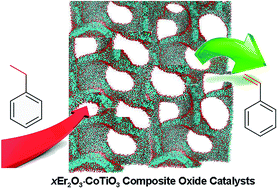Mesoporous xEr2O3·CoTiO3 composite oxide catalysts for low temperature dehydrogenation of ethylbenzene to styrene using CO2 as a soft oxidant†
Abstract
A series of mesoporous xEr2O3·CoTiO3 composite oxide catalysts have been prepared using a template method and tested as a new type of catalyst for the oxidative dehydrogenation of ethylbenzene to styrene by using CO2 as a soft oxidant. Among the catalysts tested, the 0.25Er2O3·CoTiO3 sample with a ratio of 1 : 4 : 4 content and calcined at 600 °C exhibited the highest ethylbenzene conversion (58%) and remarkable styrene selectivity (95%) at low temperature (450 °C).


 Please wait while we load your content...
Please wait while we load your content...